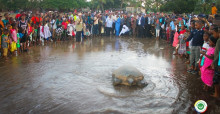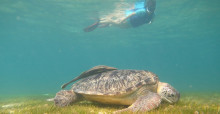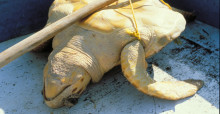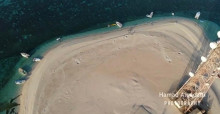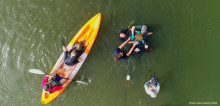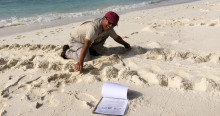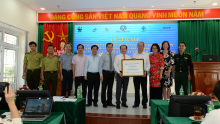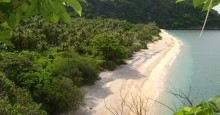By Anne-Emmanuelle Landes (1), Léo Pairain (1), Claire Jean (2), Stéphane Ciccione (2)
1. Centre d’Etude et de Découverte des Tortues Marines (CEDTM)
Chelonia mydas
The green turtle (Chelonia mydas) is the largest of all the hard-shelled sea turtles, growing up to one meter long and weighing 130-160 kg. In the western Indian Ocean adult females are larger than males, and have a more "bullseye" pattern in the scutes of the carapace.
Adult green turtles are unique among sea turtles in that as large immatures and adults they are primarily herbivorous, feeding on seagrasses and algae. Green turtles take between 20 and 50 years just to reach sexual maturity. Females return to their natal beaches (i.e., the same beaches where they were born) every 2 to 4 years to nest, laying several clutches of about 125 eggs at roughly 14-day intervals several times in a season. However, very few hatchlings survive to reach maturity – perhaps fewer than one in 1,000.
The green turtle is globally distributed and generally found in tropical and subtropical waters along continental coasts and islands roughly between 30°N and 30°S. Green turtles primarily use three types of habitat: oceanic beaches (for nesting), convergence zones in the open ocean, and benthic feeding grounds in coastal areas.
Adults migrate from foraging areas to mainland or island nesting beaches and may travel hundreds or thousands of kilometers each way. After emerging from the nest, hatchlings enter the sea and swim offshore where they enter longshore currents that take them to various oceanic areas where they are believed to get caught up in major oceanic current systems and live for several years, feeding close to the surface on a variety of pelagic plants and animals. Once the immatures reach a certain age/size range, they leave the pelagic habitat and travel to nearshore foraging grounds. Once they move to these nearshore benthic habitats, large immature and adult green turtles are almost exclusively herbivores, feeding on sea grasses and algae.
The Indian Ocean hosts some of the largest nesting populations of green turtles anywhere, particularly on oceanic islands in the southwest and on islands in SE Asia. Many of these populations are now recovering after intense exploitation in the last century dramatically reduced the populations. However, some populations are still declining. The green turtle is one of the most widely distributed and commonest of the marine turtle species in the Indian Ocean. Interactions with fishing operations are especially important threats in coastal fisheries where nets are employed, but trawl fisheries may also have important impacts.
During the 19th and 20th centuries intense exploitation of green turtles provided onboard red meat for sustained cruises of sailing vessels before the time of refrigeration, as well as meat and calipee for an international market. Several nesting populations in the Indian Ocean were devastated as a result.
The preceding biological information on marine turtle species found around the Indian Ocean is derived partly from the NOAA Fisheries, Office of Protected Resources, website:(http://www.nmfs.noaa.gov/pr/species/turtles/), supplemented by other sources (such as a website of the Australian Government, Department of Environment, Water, Heritage and the Arts -- for information on the Flatback turtle), and additional information supplied by Dr. Jack Frazier (IOSEA Advisory Committee Chair).
| CMS Instruments | CMS, IOSEA Marine Turtles, Atlantic Turtles |
|---|---|
| IUCN Status | Endangered |
| Date of entry in Appendix I | 1979 |
| Date of entry in Appendix II | 1979 |
| English | Green Turtle |
|---|---|
| French | Tortue Verte |
| Spanish | Tortuga verde |
| German | Pazifische Suppenschildkröte |
| Class | Reptilia |
|---|---|
| Order | Testudinata |
| Family | Cheloniidae |
| Scientific name | Chelonia mydas |
| Author | (Linnaeus, 1758) |
| Standard reference | Eckert, K.L., Bjorndal, K.A., Abreu-Grobois, F.A. and Donnelly, M. (Eds) (1999). Research and management techniques for the conservation of sea turtles. IUCN/SSC Marine Turtle Specialist Group Publication No.4. |
| Additional notes | In Effect 7/1/1999 |
|---|




